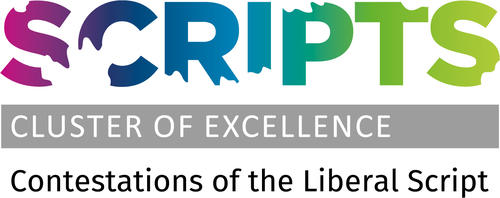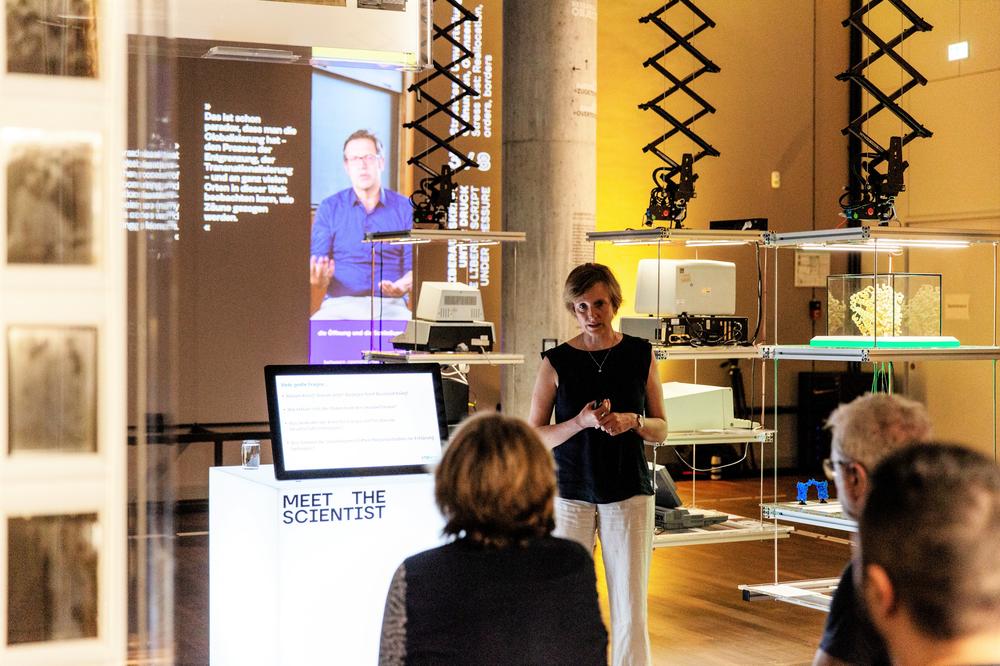Lange Nacht der Wissenschaften 2022 | "Meet the Scientists of Excellence" at the Humboldt Lab
As part of the Lange Nacht der Wissenschaften 2022, researchers from Berlin's Clusters of Excellence get into conversation (in German) about their current research with all interested Berliners. On behalf of SCRIPTS, Gwendolyn Sasse will present her current analyses of the Russian-led war in Ukraine.
What is the significance of the war in Ukraine for liberal social orders? How does a flower know when to bloom? Are active materials the stuff of our future? How can geometry lead to a more beautiful cityscape? And what happens after a stroke? In short, interactive lectures, researchers will discuss what their clusters are working on - and what excellent, interdisciplinary science looks like in the 21st century.
An event in cooperation with the Humboldt Lab of the Humboldt-Universität zu Berlin.
Programme
5:30 pm
Prof. Dr. Gwendolyn Sasse (SCRIPTS): "Russia's war against Ukraine".
Why is Russia waging war in Ukraine? What explains the unity of Ukrainian military and civil resistance? What is the significance of this war for Europe as a whole and for liberal social orders? Building on many years of social science research on identities and social mobilization in Ukraine, this conversation with renowned political scientist Gwendolyn Sasse contextualizes the current war, its background and consequences.
6 pm
Prof. Dr. Andrew James Johnson (Temporal Communities): The cluster "Temporal Communities" explores what it means when literature becomes global.
The focus is on the question of how literature creates relationships across time and space - relationships between texts and readers, between writers and artists, between different genres, media and institutions: from opera to manga to contemporary television series. Using the example of the early medieval English epic "Beowulf", we will show how such a globality unfolds across space and time, how a narrative poem from a distant and very foreign past forges multiple relationships, imagining its very own being-in-time and creating its own idea of what it means to be global.
6:30 pm
Dr. Sabine Oldemeyer (UniSysCat): "How does a flower know when to bloom?".
The sun is essential for life on earth - plants, for example, carry out photosynthesis with its help. To control this process efficiently, plants use certain proteins called cryptochromes. They respond to blue light and regulate the plant's growth and flowering time. Algae, insects and even mammals also use cryptochromes - for example, to adjust their day/night rhythm or to sense the earth's magnetic field. How these processes work is Sabine Oldemeyer's field of research. She explains why the cryptochrome "aCRY" found in green algae can even repair damage to DNA - and that in the future, light-sensitive algae may help to develop revolutionary new applications.
7:30 pm
Prof. Dr. Regine Hengge and Prof. Dr. Wolfgang Schäffner (Matters of Activity): "Active Minerals - the subststance of the future?"
At the Cluster of Excellence "Matters of Activity", the activity of materials is being rethought. For example, experts from biology and materials science work together with architects and cultural scientists to investigate the active structures and properties of wood or bacteria. The knowledge gained in this way will one day be used to develop more sustainable and energy-efficient technologies. Microbiologist Regine Hengge and cluster spokesperson Wolfgang Schäffner, historian of science and media, will provide insights into the diverse research work at the "Active Curtain Project". The "Active Curtain Project" is an ongoing experimental setup of the Cluster of Excellence "Matters of Activity". Various fragile, interactive and translucent materials made of bacterially generated and plant cellulose are woven into a curtain in the entrance area of the Humboldt Laboratory, which react to the room climate. The naturally generated material moves, connects, swells, or twists in - all without conventional mechanics. The scale and speed of the activity becomes visible in projected images and films.
8 pm
Dr. Anna Kufner (Neuro Cure): "A Look into the Brain: What happens after a Stroke?"
Neuroscientist Anna Kufner's research at Charité - Universitätsmedizin Berlin includes the effects of strokes. To do this, the research group uses a new method: the so-called "Lesion-Network Mapping (LNM) of post-stroke symptoms". With its help, it should be possible to better understand, predict and subsequently treat neurological deficits after a stroke. At the NeuroCure research station in the Humboldt Laboratory, Anna Kufner will provide insights into her scientific work and answer visitors' questions.
8:30 pm
Dr. Felix Günther and Nina Smeenk (MATH+): "Architecture and geometry"
Bending without breaking - for large glass facades, this is a difficult and expensive undertaking. In order to nevertheless meet their design requirements, architects assemble their curved surfaces from individual glass plates. Using a geometric theory of such surfaces, mathematicians have found out how futuristic glass roofs can be realized in such a way that they shine with uniform reflections in the sunlight. Their motivation: if assembled correctly, many of the properties of the round surfaces can be retained while ensuring a high degree of stability. In the lecture, visitors* will learn how geometry can lead to a more beautiful cityscape.
9 pm
Dr. David Bierbach (Science of Intelligence): "The social intelligence of animals".
Many animals show amazing cognitive performances. Using fish as an example, David Bierbach will demonstrate some of the remarkable mental feats of animals - from anticipating the future behavior of known conspecifics to copying when choosing a mate to synchronized swimming in a shoal.
Speakers
Prof. Dr. Gwendolyn Sasse, Director of the Centre for East European and International Studies (ZOiS), SCRIPTS Principal Investigator, Research unit "Borders", BGTS Faculty, Knowledge Exchange Lab Steering Committee Member.
Prof. Dr. Andrew James Johnston is Professor of English Literature with a focus on the Middle Ages and Early Modern Period at the FU Berlin and one of the two speakers of the Cluster of Excellence 2020 Temporal Communities: Doing Literature in a Global Perspective.
Dr. Sabine Oldemeyer is a postdoctoral fellow in Experimental Molecular Biophysics at Freie Universität Berlin. Her scientific focus is on light-induced processes in retinal proteins and cryptochromes.
Prof. Dr. Regine Hengge is Professor of Microbiology at Humboldt-Universität and researches how bacteria form biofilms and how they process stress. In "Matters of Activity" she investigates bacterial biofilms as an example of active matter with a focus on nano/microarchitecture and morphogenesis of biofilms.
Prof. Dr. Wolfgang Schäffner is Professor of History of Knowledge and Culture at the Humboldt-Universität zu Berlin and spokesperson of the Cluster of Excellence "Matters of Activity. Image Space Material." As project leader of "Symbolic Material" he researches and develops, among other things, common models of thought and generally understandable terms for interdisciplinary research on active materials.
Dr. Anna Kufner is a postdoctoral fellow at the Center for Stroke Research Berlin at Charité. In addition, she has been a fellow of the NeuroCure Research Fellowship since 2021 and conducts research on the symptoms that occur after a stroke.
Dr. Felix Günther is a postdoctoral researcher at the Technische Universität Berlin. In addition to his research, he is involved in science communication and talent promotion. As a member of the Junge Akademie Mainz and the Young Center for Interdisciplinary Research, he promotes exchange across disciplinary boundaries.
Nina Smeenk is a research associate at the Technische Universität Berlin. As part of her M.A., she worked in the Collaborative Research Center "Discretization in Geometry and Dynamics" in a project on geometric 3D visualization of mathematical theories until 2020.
Dr. David Bierbach is a biologist conducting research on topics ranging from individual differences to overarching collective behaviors. His research interests are in tropical freshwater fishes such as Amazonian carps (Poecilia formosa), guppies (P. formosa), and sulphur mollies (P. sulphuraria). In the Cluster of Excellence "Science of Intelligence", he is researching how fish act predictively in their social interactions - with the goal of using this knowledge to develop improved bio-mimetic robots and social interaction algorithms.
Attending the Event
- Tickets: The discussion will be part of Lange Nacht der Wissenschaften 2022, for which tickets are required. You can book tickets here (External Link).
- Registration: Ticket holders can attend without further registration
- Language: German
- Access: The Humboldt Lab is located inside of the Humboldt Forum, 1st floor. Lifts are available.
- Public Transport: You can reach Humboldt Forum via U Museumsinsel (1 min walk) which is served by Underground Line 5 or via the next larger station S/U Alexanderplatz (15 min walk) which is served by several S/U and regional trains. The closest bus stops are Lustgarten (Lines 100, 300) and Berliner Schloss (147) which are located right next to the building. Disabled parking spaces are located south of the Forum at Schlossplatz.
Time & Location
Jul 02, 2022 | 05:00 PM - 10:00 PM
Humboldt Labor im Humboldt Forum Berlin
Schloßplatz
10178 Berlin
Further Information
Review: SCRIPTS events at the Lange Nacht der Wissenschaften in recent years

